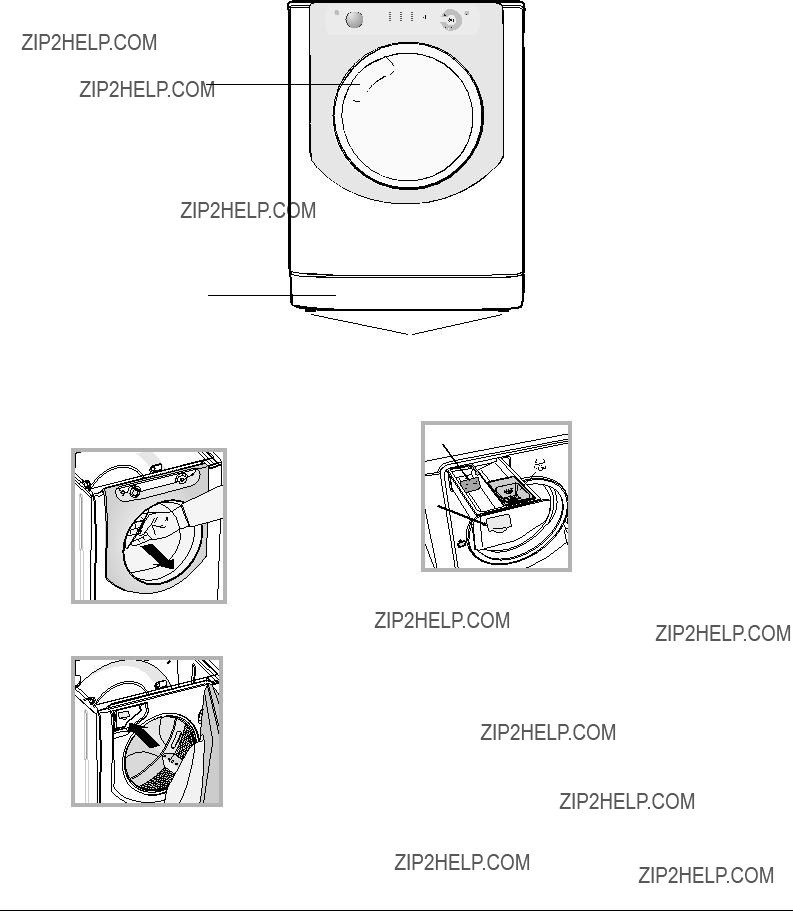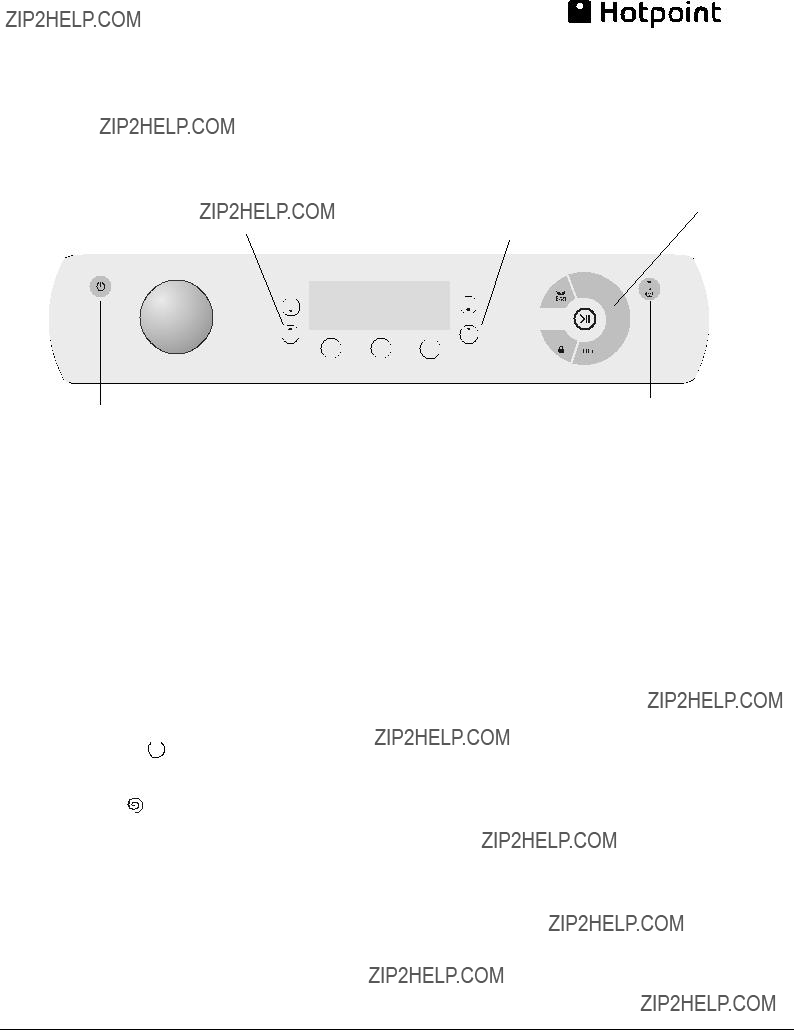Problem:
The machine does not switch on.
The wash cycle does not start.
The machine does not fill with water or Indicator light for the first wash cycle flashing rapidly.
The machine continuously fills with water and continually drains away or Water left in the drum
or Stuck on wash.
The machine does not drain or spin - (error lights flashing).
The machine does not spin.
The machine does not drain or spin - ???EASY IRON??? light flashes.
The programme takes too long.
The machine vibrates a lot during the spin cycle.
The machine is noisy.
Possible causes / Solutions:
???The appliance is not plugged into the socket fully, or not enough to make contact.
???There is no power to the socket, or the fuse has blown in the mains plug.
???The door is not closed properly.
???The ON/OFF button has not been pressed.
???The START/PAUSE button has not been pressed.
???The water tap has not been turned on to allow water to flow into the machine.
???The ???DELAY TIMER??? has been selected.
???The ???CHILD LOCK??? is activated (see ???The machine just ???beeps??? when a programme or option is selected??? below).
???The water inlet hose is kinked.
???The water inlet hose is not connected to the water supply.
???The water pressure is too low.
???The water tap has not been turned on to allow water to flow into the machine.
???There is no water supply to the house.
???The inlet valve filter is blocked.
???The START/PAUSE button has not been pressed.
???The top of the drain hose is too low - It must be fitted at a height between 65 and 100 cm from the floor (see ???Installation???).
???The drain hose is connected incorrectly to the sink trap allowing water to run into the machine, the drain hose must be positioned higher than the bottom of the sink to prevent water flowing down the drain hose.
???The end of the drain hose has been pushed too far down the standpipe, the ???U??? bracket should be fitted 100 mm from the end of the drain hose.
???The Pump filter is blocked.
???The drain hose is kinked (see ???Installation???).
???New Installation - The blanking cap or spigot has not been removed if connected under a sink.
???The drain hose or sink trap is blocked.
???The Spin Speed is set to ??? ??? position.
??? position.
???The ???EASY IRON??? option is enabled, at the end of the program the machine drum will rotate slowly. To complete the wash cycle press the ???START/PAUSE??? or the ???EASY IRON??? buttons (see Wash Cycles & Options).
???The ???SILK??? program is selected, at the end of the program it requires the drain phase to be started. To complete the program press either the ???START/PAUSE??? or ???EASY IRON??? buttons (see Wash Cycles & Options).
???Programme times will vary due to water pressure, the incoming water temperature and if the wash load goes out of balance. This will increase the programme time accordingly (see ???The machine wont spin properly??? below) - (Most Common Cause!)
???The feet have not been adjusted, enabling the machine to rock.
???New Installation - Either the Transit Bolts including the plastic spacers, or the Polystyrene Packaging have not been removed when installing the machine.
???The machine is trapped between cabinets and/or walls.
???The load is in a slight out of balance condition and machine is spinning, but at a lower speed.
???There will always be some motor, pump and drum noise during spin.






 washing additives compartment
washing additives compartment button briefly and wait for the machine to start up again.
button briefly and wait for the machine to start up again.
 ON/OFF indicator light: press this briefly to switch the machine on or off. The green indicator light indicates that the machine is switched on. To switch off the washing machine during the wash cycle, press and hold the button for approximately 3 seconds; if the button is pressed briefly or accidentally the machine will not switch off. If the machine is switched off during a wash cycle, this wash cycle will be cancelled.
ON/OFF indicator light: press this briefly to switch the machine on or off. The green indicator light indicates that the machine is switched on. To switch off the washing machine during the wash cycle, press and hold the button for approximately 3 seconds; if the button is pressed briefly or accidentally the machine will not switch off. If the machine is switched off during a wash cycle, this wash cycle will be cancelled.
 button: press to modify or exclude the temperature setting; the value selected will appear on the indicator lights above
button: press to modify or exclude the temperature setting; the value selected will appear on the indicator lights above  button: press to set a DELAY TIMER for the selected wash cycle; the set delay time will appear on the indicator lights above
button: press to set a DELAY TIMER for the selected wash cycle; the set delay time will appear on the indicator lights above  ??? Rinse
??? Rinse  ??? Spin
??? Spin  ??? Drain
??? Drain  ). The text
). The text 

 lights up when the cycle is complete.
lights up when the cycle is complete. indicator light is switched off, the door may be opened. To start the wash cycle from the point at which it was interrupted, press the button again.
indicator light is switched off, the door may be opened. To start the wash cycle from the point at which it was interrupted, press the button again. indicator light: indicates that the porthole door is locked. To open the door, pause the wash cycle (see ???
indicator light: indicates that the porthole door is locked. To open the door, pause the wash cycle (see ??? button with indicator light: to activate or deactivate the CHILD LOCK, press and hold the button for approximately 2 seconds. when the indicator light
button with indicator light: to activate or deactivate the CHILD LOCK, press and hold the button for approximately 2 seconds. when the indicator light

 icon lights up when, after altering the washing parameters, an energy saving of at least 10% is made. Furthermore, before the machine enters ???Standby??? mode, the icon will light up for a few
icon lights up when, after altering the washing parameters, an energy saving of at least 10% is made. Furthermore, before the machine enters ???Standby??? mode, the icon will light up for a few
 button. All the indicator lights will illuminate for 1 second; the indicator light corresponding to the
button. All the indicator lights will illuminate for 1 second; the indicator light corresponding to the  button will then remain lit in a fixed manner and the START/PAUSE indicator light will flash slowly.
button will then remain lit in a fixed manner and the START/PAUSE indicator light will flash slowly. Modify the temperature and/or spin speed.
Modify the temperature and/or spin speed. ). If these buttons are pressed again, the maximum values are restored.
). If these buttons are pressed again, the maximum values are restored. Setting a delayed start.
Setting a delayed start.





 Modify the cycle settings.
Modify the cycle settings. LOCK indicator light illuminates). The icons corresponding to the wash cycle phases will light up during the cycle to indicate which phase is currently in progress.
LOCK indicator light illuminates). The icons corresponding to the wash cycle phases will light up during the cycle to indicate which phase is currently in progress. indicator light is switched off you may open the door. Press the START/PAUSE button again to restart the wash cycle from the point at which it was interrupted.
indicator light is switched off you may open the door. Press the START/PAUSE button again to restart the wash cycle from the point at which it was interrupted. button until the cycle stops and the machine switches off.
button until the cycle stops and the machine switches off.





 Steam Hygiene
Steam Hygiene




 ???.
???. ,
,  ,
,  , ,
, ,  ,
, ,
,  ,
,  ,
,  ,
,  .
. Easy Iron
Easy Iron ,
, 



 ,
,  ,
,  ,
,  ,
,  .
. Eco
Eco ,
, 








 ,
,  ,
, 

 Time Saver
Time Saver ,
,  ,
, 



 ,
,  ,
,  ,
, ,
,  ,
,  ,
,  .
.


 ???. The garments will be damp once the cycle is completed, so we recommend hanging them to dry. The ???
???. The garments will be damp once the cycle is completed, so we recommend hanging them to dry. The ???


 ??? programme makes ironing easier. Moreover, with the ???Steam Perfume??? laundry balls, your favourite perfume can be added to your laundry. Place a few drops of perfume on the sponge contained inside the laundry ball, close it and insert it into the drum together with the laundry. Then launch the specific programme ???
??? programme makes ironing easier. Moreover, with the ???Steam Perfume??? laundry balls, your favourite perfume can be added to your laundry. Place a few drops of perfume on the sponge contained inside the laundry ball, close it and insert it into the drum together with the laundry. Then launch the specific programme ???


 ???. At the end of the cycle, garments will be relaxed and fragrant.
???. At the end of the cycle, garments will be relaxed and fragrant. to wash white clothes. The programme is designed to maintain the brightness of white clothes over time.
to wash white clothes. The programme is designed to maintain the brightness of white clothes over time. to wash bright coloured clothes. The programme is designed to maintain bright colours over time.
to wash bright coloured clothes. The programme is designed to maintain bright colours over time. to wash
to wash  wash cycle. We recommend that duvets are placed in the drum with their edges folded inwards
wash cycle. We recommend that duvets are placed in the drum with their edges folded inwards  .
. to wash bed
to wash bed to remove major allergens such as pollen, mites, cat???s and dog???s hair.
to remove major allergens such as pollen, mites, cat???s and dog???s hair. to wash very delicate garments having strasses or sequins. We recommend turning the garments inside out before washing and placing small items into the special bag for washing delicates. Use liquid detergent on delicate garments for best results.
to wash very delicate garments having strasses or sequins. We recommend turning the garments inside out before washing and placing small items into the special bag for washing delicates. Use liquid detergent on delicate garments for best results. and then option
and then option  ; the machine will end the cycle while the laundry is soaking and the
; the machine will end the cycle while the laundry is soaking and the  indicator light will flash. To drain the water so that the laundry may be removed, press the START/PAUSE button or the
indicator light will flash. To drain the water so that the laundry may be removed, press the START/PAUSE button or the  button. Wool: is the only washing machine brand to have
button. Wool: is the only washing machine brand to have


 ??? position
??? position

